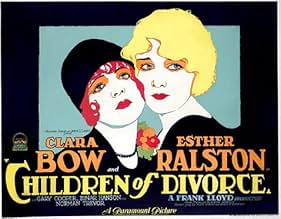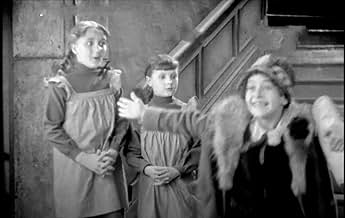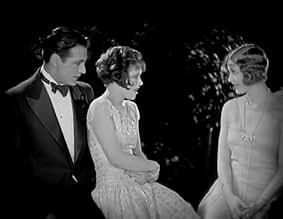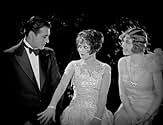Adicionar um enredo no seu idiomaA young flapper tricks her childhood sweetheart into marrying her. He really loves another woman, but didn't marry her for fear the marriage would end in divorce, like his parents'. Complica... Ler tudoA young flapper tricks her childhood sweetheart into marrying her. He really loves another woman, but didn't marry her for fear the marriage would end in divorce, like his parents'. Complications ensue.A young flapper tricks her childhood sweetheart into marrying her. He really loves another woman, but didn't marry her for fear the marriage would end in divorce, like his parents'. Complications ensue.
- Direção
- Roteiristas
- Artistas
- Boarding School Student
- (não creditado)
- Party Guest
- (não creditado)
Avaliações em destaque
Ralston claims being on the set with the 22-year-old Clara was both enjoyable and scandalous. She recalls Bow describing in detail where and how she and her actor boyfriend Cooper made love, causing cast members to experience a red glow on their faces listening to such escapades. Bow also saved Cooper's budding career by intervening on his behalf when Lloyd threatened to release the young actor for constantly not remembering his movements in a early scene. Cooper's visibility in "Children of Divorce" catapulted his screen presence, launching him towards Hollywood stardom.
As for Clara, "Children of Divorce" provided her with one of the most dramatic scenes in her growing portfolio. Near the film's ending, Bow's character swallows poison because she realizes she can't marry a prince. She lays in bed comforted by her childhood friend Jean, who forgives her for her past indiscretions. The dramatic sequence's atmosphere required more than director Lloyd provided. So Paramount brought in young director, Josef von Sternberg, who was gaining a reputation for his expert lighting, to reshoot Kitty's final moments. His genius was to provide the shadow of a curtain sweeping over her as the nun lowers the wondow drape, emphasizing the end of Kitty's tempestuous life.
This movie is a divorce trial and of wedding trial. To Avoid divorce try to succeed your marriage, it's seems evident but haw many people really think of that ?
Traumatised by abandon Kitty & Jean wanted 2 things, first never divorce, so make a good marriage.
It's such a moving Clara, who make you cry for sure, apparently she's seems happy, but inside juste broken and desperate, she always made the wrong things, thinking of course they was the best things to do,...
A movie who is still topical , even if actually divorced children are no longer abandonned.
Eternal questions: What is the way to succeed a marriage ? If it fails, divorce is a solution but how doing it softly for kids ? etc...
By their next onscreen encounter, Cooper was elevated to be the male lead, albeit in a very female centric melodrama. "Children of Divorce" is a morality tale that asks, whether children of divorced couples are more likely to become divorcees themselves. Thus, its attempt is to glorify the sacred nature of marriage by casting shame on divorced couples. It's not a subtle film. Like many a silent film, it begins with the characters as children. All three, Jean (Ralston), Kitty (Bow) and Ted (Cooper) were raised in a children's home run by nuns, because their rich, divorced parents couldn't bother to take care of the kids themselves. As they grow up, Jean and Ted are in love and want to marry, but Kitty also has an eye for Ted.
The contrast between Jean and Kitty is shown to be night and day. Jean is respectful, "wife material" so to say, while Kitty is a carefree flapper who likes to have fun. During a night when he gets drunk, Kitty tricks Ted into marrying him, and when it's announced that they are going to have a child, Jean won't allow Ted to divorce Kitty, because then world would have one more child of divorce. If you can't guess the outcome, you probably haven't watched too many silent melodramas.
I have mixed feelings about this film. The core merit it has going on, is the presence of Bow and Cooper, who are both very charismatic. The film is worth watching solely because of them. I dislike films that give such a black and white separation of good girls and bad girls. From my perspective, probably from today's perspective, Ralston appears boring and lifeless, while Clara Bow's charm has not been damaged by the years. I for one would love to wake up and discover myself married to a girl like Kitty. The film is heavy-handed with its marital themes, and it feels like it tries to brainwash the female audience into obedient housewives and dutiful mothers. Clara Bow is another alternative for a female role model, and therefore must be destroyed. "It" presented Bow's sex appeal in a lively way, and allowed it to exist. This film looks down on her, even if she is the star.
I also have never liked the American notion of "childhood sweethearts must marry as adults" in films. This is nonsense. It is very unlikely, that the first person of the opposite sex that you meet, is going to be the most suitable marital candidate you will ever meet. Therefore films like this, that tell the audience how Ted and Jean must be re-united, because they loved each other a long time ago, don't really hit home for me. There is even a creepy scene, where Ted stares at Jean, who is comforting his child, and imagines Jean as a little girl. It played the wrong way in this context, sorry.
So all in all, as a narrative, this doesn't hold up even a bit. But it does show how Cooper can act and led to better parts for him. Clara Bow may be the bad woman here, but she is easily the most memorable thing in the film.
The older girl sees a boy at the "orphanage" and vows to marry him when she's older. She grows up into Esther Ralston, and the younger girl grows up to become Clara Bow. The boy is Gary Cooper, and while he and Esther have feelings for one another, Esther isn't as pushy as the beautiful flapper. Clara is impulsive and doesn't let a little thing like friendship stand in her way. After all, how can a child of divorce really respect and value marriage?
You've been warned: this is a heavy movie, and you'll probably shed a tear by the time it's all over. But if you love watching Clara Bow movies or want to see Gary Cooper in a silent movie, you can give it a chance.
The three grow up to be Esther Ralston, Clara Bow, and Gary Cooper. Cooper is rich, Ralston has become rich and Bow is looking to become rich. The best way for her to do that is to marry Cooper who is in love with Ralston. However Cooper marries Bow after a drunken one night stand which he doesn't remember. Needless to stay things do not go smoothly and none of the principals are happy. This ultimately leads to a surprising but powerful ending with Bow giving one of her best performances. The popular moral of the story was quite clear. Marry for love and not for money or there will be consequences. But then of course it's the consequences that the mostly female audience came to see. After all CHILDREN OF DIVORCE is a 1920s "chick flick".
1927 was Clara Bow's biggest year as a box office star with IT!, WINGS, and this film among others. This was Gary Cooper's first big role and although considered miscast at the time, his performance has improved with age because of who he became. In fact this is classic Cooper although he's younger (26) then we're used to seeing him. Clara was romantically involved with Cooper at the time and lobbied for him to get the part. Esther Ralston is forgotten today but she was a big star in the late 1920s under contract to Paramount at over $1,250 a week. She was in PETER PAN (1924) and OLD IRONSIDES (1926).
Also in the cast is Hedda Hopper in a small role as Bow's mother. This is before she became celebrated as the gossip columnist famous for her hats. The pleasant surprise is how good the principal performances are considering the material. The Scottish born director Frank Lloyd had been around since the early days of silent movies (his 1917 A TALE OF TWO CITIES deserves to be restored and released) and he would go on to direct the Oscar winners CAVALCADE (1933) and MUTINY ON THE BOUNTY (1935). However this project wasn't his cup of tea so an uncredited Josef von Sternberg was brought in to tidy things up.
The other aspect of this being better than it has any right to be has to do with the restoration of the film. The original camera negative had been deposited at The Library Of Congress and a fine grain master copy was created in 1969 but parts of the movie were already beginning to deteriorate. By the turn of the century restoration technology had improved dramatically and after 7 months of laborious work using the best of both sources, this new digital version was created and it looks gorgeous. I'm one of those old school silent film enthusiasts who prefers DVDs to Blu-Rays as the latter gives us too much detail and the contrast always seems to be an issue.
However with this Flicker Alley release you can have your cake and eat it too as it contains both formats. The score by the Mont Alto Motion Picture Orchestra is also first rate. An ideal vehicle for Flicker Alley's 50th release, this is for all silent film fans. It should be pointed out that this is one of the last projects made with the help of Film Preservation Associates and Blackhawk Films head David Shepard who died earlier this year. He was one of the most important figures in silent film preservation and will be greatly missed...For more reviews visit The Capsule Critic.
Você sabia?
- CuriosidadesJosef von Sternberg was called in by Paramount to reshoot some scenes, shoot new scenes and recut the existing footage after executives made the determination that the film was not releasable.
- Citações
Kitty Flanders: You'd make a marvelous second husband but you are too much of a luxury for a poor girl's first husband.
Principais escolhas
- How long is Children of Divorce?Fornecido pela Alexa
Detalhes
- Data de lançamento
- País de origem
- Central de atendimento oficial
- Idioma
- Também conhecido como
- Children of Divorce
- Locações de filme
- Empresa de produção
- Consulte mais créditos da empresa na IMDbPro
- Tempo de duração1 hora 10 minutos
- Mixagem de som
- Proporção
- 1.33 : 1
Contribua para esta página



































